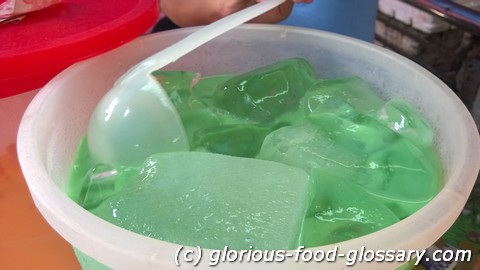Deutsch: Samalamig / Español: Samalamig / Português: Samalamig / Français: Samalamig / Italiano: Samalamig
Samalamig refers to a variety of traditional Filipino cold drinks and refreshments, typically served to quench thirst and cool down on hot days. These beverages are often made from a mix of fruits, beans, jellies, and sweet syrups, and are known for their vibrant colors and refreshing flavors. Samalamig is popular as street food and is commonly sold in markets, festivals, and by street vendors across the Philippines. Varieties include drinks made with ingredients like sago (tapioca pearls), Gulaman (agar-agar jelly), coconut, and various native fruits and beans.
Description
Samalamig serves as a general term for a category of Filipino cold refreshments that are both delicious and hydrating. These drinks are characterized by their sweetness and often, the inclusion of chewy elements like tapioca pearls or jelly cubes, which add a unique texture to the beverages. The preparation of samalamig varies widely, allowing for a range of flavors and ingredients that reflect the Philippines' rich culinary diversity.
Application Areas
In the Philippines, samalamig is a staple at informal gatherings, local celebrations, and everyday street food culture. It is especially popular during the summer months and at outdoor events, providing relief from the tropical heat. Samalamig is not only a treat for the palate but also an integral part of the Filipino community life, bringing people together over shared flavors and experiences.
Well-Known Examples
- Sago at Gulaman: A sweet drink made with tapioca pearls (sago) and agar-agar jelly (gulaman), sweetened with brown sugar syrup and often flavored with pandan.
- Halo-Halo: Although more of a dessert than a drink, halo-halo includes crushed ice with a mix of fruits, beans, milk, and sweet ingredients, sometimes served with a scoop of ice cream on top.
- Buko Juice: Fresh coconut water served with young coconut meat, often sweetened and chilled.
- Iskrambol: A creamy, ice-based treat mixed with milk, sugar, and sometimes food coloring, topped with chocolate syrup and powdered milk.
Treatment and Risks
Samalamig drinks are generally safe to consume and can provide hydration and quick energy boosts due to their sugar content. However, individuals with dietary restrictions or those monitoring their sugar intake should consume these beverages in moderation. As with all street-sold foods, the hygiene standards of the vendor should also be considered to avoid potential health risks.
Recipes
Simple Sago at Gulaman Recipe:
Ingredients:
- 1/4 cup tapioca pearls (sago)
- 1 cup brown sugar
- 5 cups water
- 1 cup agar-agar jelly (gulaman), cubed
- Crushed ice
- Pandan leaf for flavor (optional)
- Boil tapioca pearls in water until they become translucent and soft. Drain and set aside to cool.
- Make a syrup by boiling brown sugar with water and a pandan leaf (if using) until the sugar is fully dissolved. Allow it to cool.
- Prepare the agar-agar jelly according to package instructions, cut into cubes, and chill.
- To serve, mix the sago and gulaman cubes in a glass, add crushed ice, and pour the sweet syrup over the top.
- Stir well before drinking.
Similar Terms or Synonyms
While samalamig specifically refers to Filipino cold and sweet beverages, similar types of refreshing drinks in other cultures might be known as "iced sweet beverages" or "cold desserts" depending on their consistency and ingredients.
Summary
Samalamig encompasses a delightful array of cold, sweet beverages that are deeply embedded in Filipino culture, offering a refreshing escape from the heat with their unique flavors and textures. These drinks not only serve as a testament to the Philippines' inventive use of local ingredients but also as a beloved part of daily life and festivities, cherished by Filipinos of all ages.
--

Related Articles to the term 'Samalamig' | |
| 'Omija Hwachae' | ■■■■■■■■■■ |
| Omija Hwachae is Omija fruit punch. Omija Hwachae is one of the popular traditional Korean drinks for . . . Read More | |
| 'Calamansi' | ■■■■■■■■■■ |
| Calamansi in the food context refers to a small, citrus fruit native to the Philippines and other Southeast . . . Read More | |
| 'Bubur Cha Cha' | ■■■■■■■■■ |
| Bubur Cha Cha refers to one of Malaysia\'s popular dessert which is cooked with yam, sweet potatos, bananas, . . . Read More | |
| 'Dalanghita' | ■■■■■■■■■ |
| Dalanghita in the food context refers to a type of citrus fruit that is widely cultivated and consumed . . . Read More | |
| 'Traditional and Popular Snacks of Korea' | ■■■■■■■■ |
| Traditional and Popular Snacks of Korea: Koreans have developed a variety of traditional sweets and beverages . . . Read More | |
| 'Bagoong' | ■■■■■■■■ |
| Bagoong is the Filipino term for fermented shrimps or fish, There are different varieties of Bagoong . . . Read More | |
| 'Tamarind' | ■■■■■■■■ |
| Indian: Puli, Valanpuli Tamarind refers to the pod of the tree Tamarindus indica, the pulp of which is . . . Read More | |
| 'Tapuy' | ■■■■■■■■ |
| Tapuy is a traditional Filipino alcoholic beverage made from fermented glutinous rice. This unique drink . . . Read More | |
| 'Dirty Ice Cream' | ■■■■■■■■ |
| Dirty Ice Cream in the food context refers to a colloquial term used in the Philippines to describe homemade . . . Read More | |
| 'Maruya' | ■■■■■■■■ |
| Maruya is a traditional Filipino snack made from bananas, typically Saba bananas, which are battered . . . Read More | |
